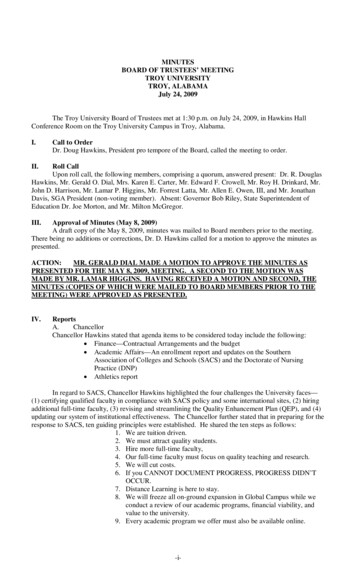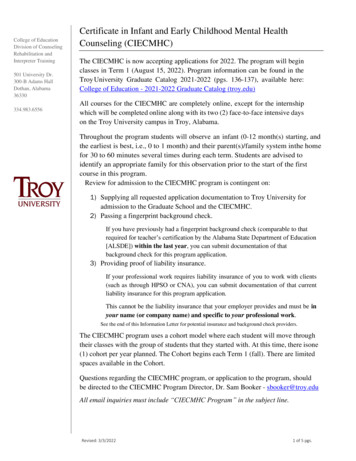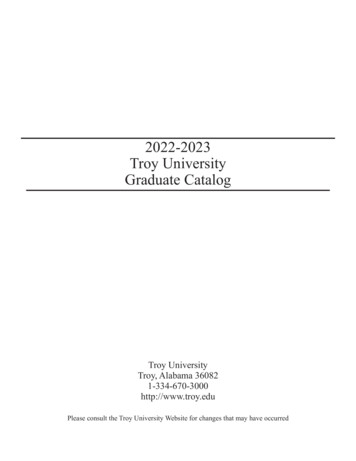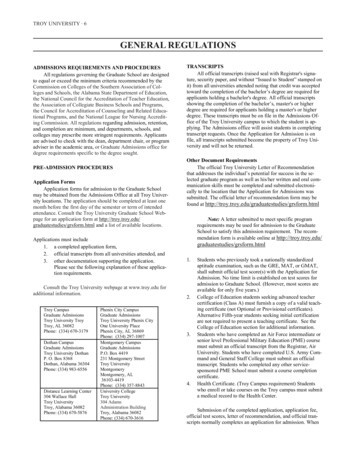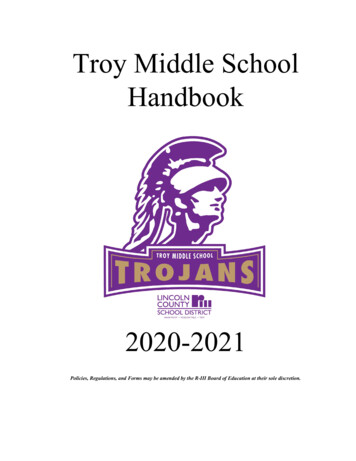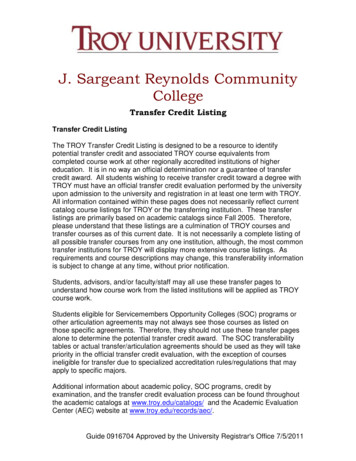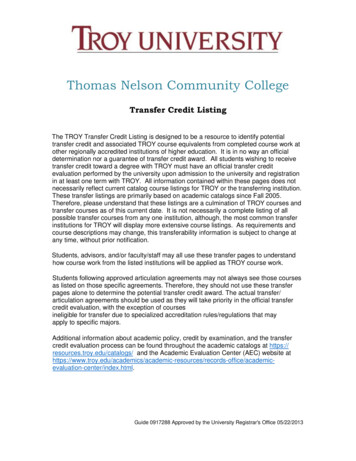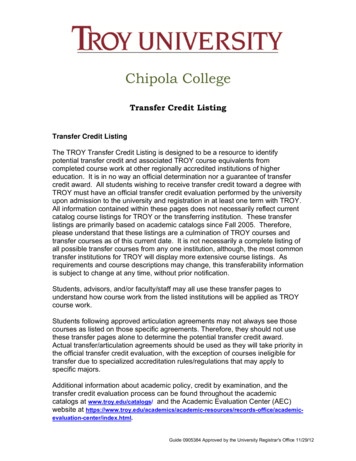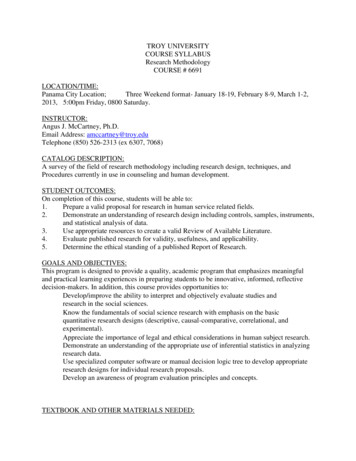
Transcription
TROY UNIVERSITYCOURSE SYLLABUSResearch MethodologyCOURSE # 6691LOCATION/TIME:Panama City Location;Three Weekend format- January 18-19, February 8-9, March 1-2,2013, 5:00pm Friday, 0800 Saturday.INSTRUCTOR:Angus J. McCartney, Ph.D.Email Address: amccartney@troy.eduTelephone (850) 526-2313 (ex 6307, 7068)CATALOG DESCRIPTION:A survey of the field of research methodology including research design, techniques, andProcedures currently in use in counseling and human development.STUDENT OUTCOMES:On completion of this course, students will be able to:1.Prepare a valid proposal for research in human service related fields.2.Demonstrate an understanding of research design including controls, samples, instruments,and statistical analysis of data.3.Use appropriate resources to create a valid Review of Available Literature.4.Evaluate published research for validity, usefulness, and applicability.5.Determine the ethical standing of a published Report of Research.GOALS AND OBJECTIVES:This program is designed to provide a quality, academic program that emphasizes meaningfuland practical learning experiences in preparing students to be innovative, informed, reflectivedecision-makers. In addition, this course provides opportunities to:Develop/improve the ability to interpret and objectively evaluate studies andresearch in the social sciences.Know the fundamentals of social science research with emphasis on the basicquantitative research designs (descriptive, causal-comparative, correlational, andexperimental).Appreciate the importance of legal and ethical considerations in human subject research.Demonstrate an understanding of the appropriate use of inferential statistics in analyzingresearch data.Use specialized computer software or manual decision logic tree to develop appropriateresearch designs for individual research proposals.Develop an awareness of program evaluation principles and concepts.TEXTBOOK AND OTHER MATERIALS NEEDED:
Heppner, P. P., Kivilinghan, D. M., & Wampold, B. E. (latest edition). Research designin counseling. Pacific Grove, CA: Brooks/ Cole.RECOMMENDED ADDITIONAL READING:As needed for projectsRESEARCH COMPONENT:Students will prepare a Research Proposal as a major factor of the course and will be requiredto do an exhaustive literature search concerning their area of interest.ENTRANCE COMPETENCIES:Currently enrolled graduate student in good standing.COURSE REQUIREMENTS:1.Candidates must satisfactorily meet all goals/objectives used to assess SDE rules.2.Completion of LIVE TEXT Common Assignments listed below.3.Completion and submission of a Critique of Published Research.LIVETEXT/BLACKBOARD Common Assignments:All students taking course must complete the following assignments.Prior to completing the first LiveText Assignment for this course, students must complete theDemographic Form CP 6691 located in the Forms Section of LiveText.LIVETEXT ASSIGNMENT 1Research ProposalStudent AssignmentCACREP 2009 Standards Section II.G. 8. a, b, c, & eStudent Directions – Prepare a research proposal following the guidelines provided below.The paper should be a WORD document and submitted to the instructor via LiveText.Common Assignment/Assessment 1 (Research Proposal) Description:The proposal will consist of an introduction, a review of the literature, and a methodologysection. The introduction and literature review sections must have a total of not less than10 recent, original, quality, and professional references to support the research endeavorand develop the logic justifying the need for the research. Of the 10 references, at least 8must be articles reporting original research. The methods section will contain a detailedprocedure for conducting the proposed research project. Please keep in mind that you arenot going to be required to do the project but simply to propose it in a comprehensivewritten document. The final research proposal must be typed, double spaced, andprepared in accordance with APA publication guidelines.RESEARCH PROPOSAL LIVETEXT RUBRIC
INSTRUCTOR GRADES ASSIGNMENT 1 RESEARCH PROPOSAL AFTERSTUDENT SUBMITS ssmentDesigning ResearchResearch Proposal:APA -CF.8Research Proposal:Statement of the ProblemII.G.8.a., 8Research Proposal:Literature ReviewII.G.8.a., 8Research Proposal:MethodologyII.G.8.b., F.3AL-Troy-COE-CF.5UnderstandingAverageDoes not followAPA style andis poorlywritten.Missing orincorrect titlepage, 13 citation errors,8 headingerrors, 10 reference formaterrorsMany APAerrors and isbelow averagein writing.Title page, 7-12citation errors,5-7 headingerrors, 6-9referenceformat errorsHas some APAerrors and isacceptablywritten.Correct titlepage, 4-6citation errors,3-4 headingerrors, 3-5referenceformat errorsHas few APA errorsand is well written.Correct title page,2-3 citation errors,1-2 heading errors,1-2 reference formaterrorsUses APA style andis well written.Correct title page,citations, headings,grammar, andreference formatno orunacceptablestatement of theproblemNo statement ofthe problem or astatement of theproblem that isunclear andcontains nosourcesubstantiation.inconsistent orpoorly wordedstatement of theproblemStatement of theproblem is notclearly definedand is notwell-sourced.definedstatement of theproblemStatement of theproblem isclearly definedbut is notwell-sourced.clearly definedstatement of theproblemStatement of theproblem is clearlydefined andwell-sourced but isnot relevant to thestudent’s specificcounselingspecialty.well decided andarticulated statementof the problemStatement of theproblem is clearlydefined,well-sourced, andrelevant to thestudent’s specificcounseling specialtyUnorganizedand illogicalliterature reviewconsisting ofmostlysecondarysourcesLess than 6primary sourcedocumentsincluded, nodescription ofthemethodologyfor sources, nointegration ofthe findingswith each other,two levels ofheading withinthe literaturereviewPoorly writtenliteraturereview6-7 primarysourcedocumentsincluded, nodescription ofthemethodologyfor sources,little or nointegration ofthe findingswith each other,two levels ofheading withinthe literaturereviewClear literaturereview6-7 primarysourcedocumentsincluded, someresearchfindingspresented alongwith a briefdescription ofthemethodologyfor somesources, littleintegration ofthe findingswith each otheror comparingfindings, andthree levels ofheading withinthe literaturereviewIntegrated literaturereview of primarysourcedocumentation8 primary sourcedocuments included,major researchfindings presentedfrom each primarysource along with abrief description ofthe methodology foreach source, someresearch findings areintegrated with eachother andcompared/contrastedwith one another,and three levels ofheading within theliterature reviewComprehensiveliterature review ofprimary sourcedocumentation8 primary sourcedocuments included,major researchfindings presentedfrom each primarysource along withbrief description ofthe methodology foreach source,research findings areintegrated with eachother andcompared/contrastedwith one another,and three levels ofheading within theliterature reviewVery limitedmethodology.Themethodologydoes not containa hypothesis orthe hypothesis isnot related tothe researchLimitedmethodology.Themethodologycontains ahypothesis thatis related to ogycontains ahypothesis thatcan clearly testthe researchquestion. TheAbove averagemethodology with aspecific designstatement.The methodologycontains ahypothesis that canclearly test theresearch question.Superiormethodology with aspecific designstatement and asection addressingaudience utilizationof possible results.The methodology
AL-Troy-COE-CF.6AL-TROY-COE-CF.8Research Proposal: OverallGrade II.G. 8. a, b, c, & equestion.Sectionsdescribing edure, andinstrumentationare vague,impractical, ormissing. Nosectionaddressingaudienceutilization ofpossible resultsis included.Sectionsdescribing edure, andinstrumentationare vague,impractical, ormissing. Nosectionaddressingaudienceutilization ofpossible resultsis onprocedure, andinstrumentationof the researchproject areacceptablydescribed butcontain nosourcesubstantiation.No sectionaddressingaudienceutilization ofpossible resultsis included.The population,sampling procedure,implementationprocedure, andinstrumentation ofthe research projectare all clearlydescribed andsourced asappropriate.However, no sectionaddressing audienceutilization ofpossible results isincluded.contains ahypothesis that canclearly test theresearch question.The population,sampling procedure,implementationprocedure, andinstrumentation ofthe research projectare all clearlydescribed andsourced asappropriate. Inaddition, a sectionaddressing audienceutilization ofpossible results isincluded.NoUnderstandingof ResearchproposalBelowAverageUnderstandingof ResearchproposalAverageUnderstandingof ResearchproposalUnderstanding ofResearch proposalMasteryExcelsUnderstanding ofResearch proposaloptionalLIVETEXT ASSIGNMENT 2IRB Training ModuleStudent AssignmentCACREP 2009 Standards Section II. G. 8. fStudent Directions – Complete the official Troy authorized IRB training course, scan yourresults/certificate of completion and submit to the instructor in LiveText.Common Assignment/Assessment 2 (IRB Training Module) Description:Students will be required to complete the official Troy authorized IRB training courseassigned to you by the instructor as evidenced by successful completion of the associatedquiz at the 80% correct level. The quiz results must be appropriately documented andsubmitted to the instructor via LiveTextIRB TRAINING MODULE LIVETEXT RUBRICINSTRUCTOR EVALUATES ASSIGNMENT 2 IRB TRAINING MODULE AFTERSTUDENT SUBMITS RESULTS (scanned copy) IN LIVETEXT TO PROFESSORTopicStandardAssignment/AssessmentIRB Training -COE-CF.3AL-Troy-COE-CF.510-59%NoUnderstandingWas able tosuccessful answer0-59% indicatingvery poorunderstanding ofethics andprotection elowAverageAverageMasteryExceptionalWas able tosuccessfulanswer 60-69%of the questionsindicating poorunderstanding ofethics andprotection ofhumanparticipants.Was able tosuccessfulanswer 70-79%of the questionsindicatingaverageunderstanding ofethics andprotection ofhumanWas able tosuccessfulanswer 80-89%of the questionsindicating aboveaverageunderstanding ofethics andprotection ofhumanWas able tosuccessful answer90-100% of thequestionsindicating verysuperiorunderstanding ofethics andprotection ofhuman
cipants.participants.COMMON ASSIGNMENT 3 (Blackboard or Face-to-Face)Program Evaluation Research-QuizStudent AssignmentCACREP 2009 Standards Section II. G. 8. c & dAL-ASBE-6.290.3.3.50.2.A.1 AL-TROY-COE-CF.3,AL-Troy-COE-CF.5 AL-Troy-COE-CF.6 AL-TROY-COE-CF.8Student Directions – Complete the Program Evaluation Research-Quizfollowing the guidelines provided below.Common Assignment/Assessment 3 (Program Evaluation Research-Quiz) Description:This is an objective quiz found on Blackboard or given face-to-face with the instructor.Topics on this quiz will include: needs assessment approaches, summative vs formativeevaluation, process evaluation, cost effectiveness, and outcome evaluation.Program Evaluation Research Quiz: CACREP II.G.8.c., II.G.8.d.;AL-ASBE-6.290.3.3.50.2.A.1 AL-TROY-COE-CF.3, AL-Troy-COE-CF.5AL-Troy-COE-CF.6 AL-TROY-COE-CF.8CP 6691 Research Methodology (Instructor)LiveText Instructor’s Standards Summary FormCACREP 2009 Standards – Section G.8Instructor completes form at the end of the course. This form assesses student progress inmeeting CACREP objectives and provides summary assessment information for programevaluation. The form is completed by the instructor at the end of the semester/term.The following is a summary template of common assignments/assessments that align withCACREP 2009 Standards and Alabama State Department of Education School CounselingStandardsStudent Directions – The student will submit the assignment named CP 6691Research Methodology Instructor’s Summary Student Document to theinstructor in LiveText. Attach the CRITIQUE paper here.TopicStandardAssignment/AssessmentLiveText Assignment Exceptional0-59%No
Research ProposalCACREP OE-CF.8LiveText Assignment 2IRB Training Module:CACREP Common Assignment 3Program EvaluationResearch-Quiz:CACREP II.G.8.c., 8understanding of ResearchProposalaverageunderstanding of ResearchProposalunderstanding of ResearchProposalaverageunderstanding of Researchproposalunderstanding of ResearchProposalNounderstanding of IRBProcessBelowaverageunderstanding of IRBProcessAverageunderstanding of IRBProcessAboveaverageunderstanding of IRBProcessExceptionalunderstanding of IRBProcessNounderstanding of ProgramEvaluationBelowaverageunderstanding of ProgramEvaluationAverageunderstanding of ProgramEvaluationAboveaverageunderstanding of ProgramEvaluationExceptionalunderstanding of ProgramEvaluation.METHOD OF INSTRUCTION:Lecture and DidacticMETHOD OF EVALUATION:ObjectiveASSIGNMENT OF GRADES: total points 41-45 A, 35-40 B, 30-34 points C.1.2.3.Completion of LIVE TEXT assignments 2 and 3 by due dates, max 5 points each,.Critique, (presentation to class and written paper), max 10 points.Submission of the Research Proposal via LIVE TEXT, max 25 points, (serves asthe final test)CLASS SCHEDULE AND ASSIGNMENTS:January 18First Class, housekeeping, purposes of research in counselingJanuary 19The Research question. Giving meaning to statisticsJanuary 19Proposal development, statistics part 2February 8The Critique, Understanding the research of othersFebruary 9Presentation of critiques, Proposal developmentFebruary 9Presentation of critiques, Proposal developmentMarch 1Program Evaluation and enhancementMarch 2Final proposal questions and research development issuesMarch 2Final class, all assignments due in livetext and print
CRITIQUE:Each student will submit an APA style paper via live text (submitted as Instructor’s summarystatement) and make a class presentation critiquing a report of research from a peer reviewedprofessional journal. The critique paper will cover the following outline.The outline for the written critique will be:The title of the article being critiqued and where it was found,the type of research design used,the basic question posed by the researcher,the type of sampling used,a review of the instruments used (if any),type of statistical analysis used,a summary of the research findings,and a critique of the content to include;usefulness of findings,generalizability of results,ethical considerations,and threats to internal validity.ATTENDANCE POLICY:Attendance is mandatory. No automatic cuts are authorized. Excessive absences will bereported to appropriate VA and military officials. Arrangements for excused absences must bemade PRIOR to the absence.MAKE-UP WORK POLICY:All classes missed must be made up, regardless of whether the absences were excused orunexcused. Make-up assignments will be given by the instructor on an individual basis.INTERNET:You may be expected to use the Internet as a part of your course work, as determined byyour instructor.ADDITIONAL INFORMATION:Textbook and Other Materials NeededStudents should order textbooks as soon as possible to insure receipt prior to the beginning of theterm. Troy University’s official bookstore is MBS Direct athttp://bookstore.mbsdirect.net/troy.htm MBS is the official provider of the approved textbooksfor each term. Orders may be placed online with a credit/debit card or by phone(1-800-325-3252). Students purchasing textbooks from other sources do so at their own risk inrelation to order accuracy, timely receipt, or completeness of materials.Americans With Disabilities Act (ADA):Troy University supports Section 504 of the Rehabilitation Act of 1973 and the Americans withDisabilities Act of 1990, which insure that postsecondary students with disabilities have equalaccess to all academic programs, physical access to all buildings, facilities and events, and arenot discriminated against on the basis of disability. Eligible students, with appropriatedocumentation, will be provided equal opportunity to demonstrate their academic skills andpotential through the provision of academic adaptations and reasonable accommodations.Further information, including appropriate contact information, can be found at the link for TroyUniversity s Office of Human Resources at
tmSTANDARDS OF CONDUCT:The commission of or the attempt to commit any cheating and/or plagiarism are in violation ofthe Standard of Conduct stated in the Troy University Florida Student Handbook, and may bedisciplined up to and including suspension and expulsion.Plagiarism is the passing off of the thoughts or works of another as one s own. Plagiarisminvolves giving the impression that a person has thought, written, or produced something thathas, in fact, been borrowed from another. Plagiarism may result from poor technique of citationor more serious cases as: copying the work of another person; submitting the work of anotherperson; or closely paraphrasing a piece of work without due acknowledgement.Questions about plagiarism? Go to mALLEGATIONS OF PLAGIARISM:Depending on the circumstances, the penalty imposed for plagiarism may include warning,resubmission, loss of marks, failure on a particular assignment or course, or a charge ofmisconduct to be dealt with by Troy University.INCOMPLETE GRADE POLICY:An incomplete grade indicates that the student has not completed all of the assigned class work orhas not taken all class examinations, but is otherwise passing the course. Only the instructor candetermine whether an incomplete grade is justified. It cannot be automatically assigned, butrather must be requested by the student by submitting to the instructor the Petition for and Workto Remove an Incomplete Grade form. If the Petitions are approved, a signed copy will be mailedto the student. An "I" can never be used in lieu of an "F" nor can an "I" be assigned because ofexcessive absences.It is the student's responsibility to contact the instructor regarding the deadline for completing allcourse requirements. Any student who receives a grade of Incomplete must adhere to the workcompletion deadline set by the instructor, not to exceed the end of the following term. Thisdeadline applies whether or not the student re-enrolls for the semester following the assignmentof the incomplete grade (s). Failure to clear the incomplete within the specified time period willresult in the assignment of a grade of F for the course.LIBRARY SUPPORT:The Libraries of Troy University provide access to materials and services that support theacademic programs. The address of the TROY Global Campus Library Web site, which servesall Global Campus students, is http://uclibrary.troy.edu. This site provides access to theLibrary's Catalog and Databases, as well as links to all Campus libraries and online or telephoneassistance by Troy Library staff. Additionally, the Library can be accessed by choosing the"Library" link from the University's home page, www.troy.edu.TROY EMAIL:All Troy students will be required to access and utilize their troy.edu email account for allcommunication with the university. All official correspondence (including bills, statements,emails from distance learning instructors through Blackboard, assignments and grades fromdistance learning instructors, etc.) will be sent only to the troy.edu address. Your troy.edu emailaddress is the same as your web express user ID followed by @troy.edu.You can get to
your email account through our web page www.troy.edu/fwr or you can go to the email linkfound there and learn how to add this address to your other email services that support POPaccounts (i.e. Outlook, Outlook Express, Yahoo, AOL, etc.).CELL PHONES AND OTHER ELECTRONIC DEVICES USED IN THE INSTRUCTIONALENVIRONMENT:Use of any electronic devise by students in the instructional environment is prohibited unlessexplicitly approved on a case-by-case basis by the instructor of record or by the Office ofDisability Services in collaboration with the instructor. Cellular phones, pagers, and othercommunication devices may be used for emergencies, however, but sending or receivingnon-emergency messages is forbidden by the University. Particularly, use of a communicationdevice to violate the Troy University Standards of Conduct will result in appropriatedisciplinary action (See pp. 42-52 of the Oracle.In order to receive emergency messages from the University or family members, the call receiptindicator of devises must be in the vibration mode or other unobtrusive mode of indication.Students receiving calls that they believe to be emergency calls must answer quietly withoutdisturbing the teaching environment. If the call is an emergency, they must move unobtrusivelyand quietly from the instructional area and notify the instructor as soon as reasonably possible.Students who are expecting an emergency call should inform the instructor before the start of theinstructional period.COMMENTS & QUESTIONS:At Troy University, students are our most valuable commodity. If you have any comments orquestions about this course, please do not hesitate to contact me.
TROY UNIVERSITY COURSE SYLLABUS Research Methodology COURSE # 6691 LOCATION/TIME: Panama City Location; Three Weekend format- January 18-19, February 8-9, March 1-2, 2013, 5:00pm Friday, 0800 Saturday. INSTRUCTOR: Angus J. McCartney, Ph.D. Email Address: amccartney@troy.edu Telephone (850) 526-2313 (ex 6307, 7068) CATALOG DESCRIPTION:
